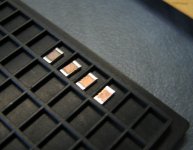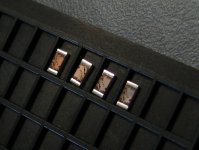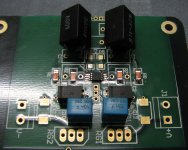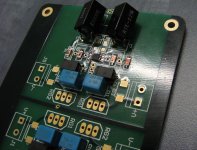Yah, for a 1k feedback resistor it's about 100nV RMS in favor to the the AD797, assuming typ parts and a 20k bandwidth. That's approximately do not breathe on measurement setup levels and negligible compared to the ground bounce developed across unbalanced interconnects---even with balanced interconnects and 0.1% resistors it's likely smaller than the ground bounce that gets through the receiver's 60dB CMRR. Glen, more on op amp noise models here or in any number of other references.I don't think your noise performance will be lower than LME49990, which requires none of that (except the bypassing)
That said, I want some of these anyway, just because they're cool. RGs are rather more affordable, though.
thats assuming a good PCB for the AD797, which is certainly not guaranteed here.
why bother with the vishay part when you can order the exact value you need from the company that developed the technology Texas components even if its a single 835.45 ohms chip its still slightly cheaper to order direct. I already use the ASMP in my headphone amps and IV, have so for years, excellent resistors. the Texas parts are cooler too, they have a clear conformal coating, so they are 'naked' like their bretheren.
why bother with the vishay part when you can order the exact value you need from the company that developed the technology Texas components even if its a single 835.45 ohms chip its still slightly cheaper to order direct. I already use the ASMP in my headphone amps and IV, have so for years, excellent resistors. the Texas parts are cooler too, they have a clear conformal coating, so they are 'naked' like their bretheren.
Attachments
Last edited:
Sure, but the point was the 49990's current noise is negligibly higher than the 797 even in the ideal case where the 49990 might arguably be lower performance.
Interesting about Texas Components. I've yet to hit a problem I couldn't solve satisfactorily with standard values and it their website doesn't seem to offer online ordering; is this a must call/email/fax a special order kind of arrangement?
Interesting about Texas Components. I've yet to hit a problem I couldn't solve satisfactorily with standard values and it their website doesn't seem to offer online ordering; is this a must call/email/fax a special order kind of arrangement?
oh I know, wasnt arguing with what you said I agree, but I think swapping into a design not made for it the lme would have the advantage.
yep email only, they make to order with most orders, but do hold some standard values in stock I think. still very slightly cheaper even if you dont need the custom value, they even make resistor networks using the same tech, you can order in global + relative value match in pairs, quads etc. I mostly just stick to global, but for the above I got the sets as relative pairs too
yep email only, they make to order with most orders, but do hold some standard values in stock I think. still very slightly cheaper even if you dont need the custom value, they even make resistor networks using the same tech, you can order in global + relative value match in pairs, quads etc. I mostly just stick to global, but for the above I got the sets as relative pairs too
thats close enough to just call unity.... so I did... really without careful layout and without some additions, I wouldnt use it lower than 4x. AD797 not properly implemented will be handily beaten by lme49990, which is a fairly bulletproof chip too, cheap as well.
AD797 even has completely different pins that need to be used to gain best performance from it (pin 8) that are probably just tied to ground or unconnected on your layout. once you combine figure 39. figure 42. and figure 44 (along with the recommended psu bypassing) without a suitable PCB..... I dont think your noise performance will be lower than lme49990, which requires none of that (except the bypassing)
great chip, but its a princess (sorry Scott =) you know its true)
thanks again for jumping in on this
I will use compensation from pin 8 as everyone who uses this chip says it`s mandatory
right now it is without comp on brown dogs and either the crappy smd components are making it sound bright or it`s oscillating and I won`t know till I get an oscilloscope because it`s not overheating but it`s like someone throwing glass in my eyes lol
what should I look for in used o scope?
downloaded pdf for lme49990 and looks to be similar speed and may change to something different for op but for now I will try 797 but in between jobs right now so all on hold
thanks for the strait answers
Glen
Yah, for a 1k feedback resistor it's about 100nV RMS in favor to the the AD797, assuming typ parts and a 20k bandwidth. That's approximately do not breathe on measurement setup levels and negligible compared to the ground bounce developed across unbalanced interconnects---even with balanced interconnects and 0.1% resistors it's likely smaller than the ground bounce that gets through the receiver's 60dB CMRR. Glen, more on op amp noise models here or in any number of other references.
That said, I want some of these anyway, just because they're cool. RGs are rather more affordable, though.
I as of yet do not understand common mode rejection?
I assume ground bounce is noise from ground or virtual ground?
thanks for the links and I have heard stellar opinions on vishay bulk foil and less so on sumono and yes I will fork over the ridiculous price for the final outcome because I have heard they are liquid audio whatever that means?
It sounds yummy lol
Glen
Tek 2215 is a good starting point.what should I look for in used o scope?
See references linked previously.I as of yet do not understand common mode rejection?
That's part of it, though non-noise currents can easily dominate---ground traces/wires/planes/whatever have nonzero impedance so the potential varies across them. For example, a power amp usually pulls more current than a DAC or preamp so its ground voltage changes more with the charging pulses through its bridge. Since an unbalanced interconnect has 0dB CMRR all of the difference between the DAC/preamp and power amp's ground potential is seen as signal at the power amp input. Multiply by a typical power amp gain of 25-30dB and one begins to have a case for why things like power cords can be audible.I assume ground bounce is noise from ground or virtual ground?
Generally speaking if your design has a hard requirement for better than 0.5% Susumu RRs or similar it's probably not the right design---think twice before spending more than 10 or 11 cents on a resistor. That said, 0.1% RGs are under 50 cents in small quantities so they can be attractive if one's in a mood to splurge a little.I will fork over the ridiculous price for the final outcome because I have heard they are liquid audio whatever that means?
I might be forgetting something but I think the most expensive resistors I've ever bought are Vishay RH050s for power amp testing---for DACs if you need more than a 1/10W 0603 there's a decent chance you're doing something wrong. That doesn't mean the possibility of buying matched quads isn't pretty cool but, let's be realistic, in most applications it's like buying a $100 bottle of wine rather than a $10 bottle---you do it because you want to, not because you need to.
Oh, sure I agree. Though either of these op amps is arguably overkill; the 49990 or 797 doesn't move THD+N much to the left of a 49710, 49722, 49724, or 49740.oh I know, wasnt arguing with what you said I agree, but I think swapping into a design not made for it the lme would have the advantage
THD yes, but apart from in regulators ive not really been much of a fan of those, maybe its snobbery =) but there are other factors, the input offset of the 49710 isnt so hot from memory either.
they are actually cheaper than I remember for the ASMP. I checked back last night, I was thinking of the matched sets price or a higher resistance I think, just normal global match ASMP1206 zfoils for the low range values (they get more expensive as the resistance gets higher, longer laser etching/cnc path I guess) like less than 1kohm its $7.84ea for 0.1% more for the matched quads but thats just to satisfy neurosis
I like RG too, they are my second choice, well vishay MELF arent too bad, but at some suppliers you dont pay that much less than the foils
liquid? lol sorry I dont really do that sort of language, the naked resistors are not really naked, they have a clear conformal coat, its the foil element that makes the difference, not being 'nude'
really excellent for TC, any application that might show some self-heating from voltage or whatever, for that the zfoils blow everything else away, rock solid, check the video out where he points a hot air tool at them after freezing them, doesnt budge
they are actually cheaper than I remember for the ASMP. I checked back last night, I was thinking of the matched sets price or a higher resistance I think, just normal global match ASMP1206 zfoils for the low range values (they get more expensive as the resistance gets higher, longer laser etching/cnc path I guess) like less than 1kohm its $7.84ea for 0.1% more for the matched quads but thats just to satisfy neurosis
I like RG too, they are my second choice, well vishay MELF arent too bad, but at some suppliers you dont pay that much less than the foils
liquid? lol sorry I dont really do that sort of language, the naked resistors are not really naked, they have a clear conformal coat, its the foil element that makes the difference, not being 'nude'
really excellent for TC, any application that might show some self-heating from voltage or whatever, for that the zfoils blow everything else away, rock solid, check the video out where he points a hot air tool at them after freezing them, doesnt budge
Last edited:
It's 50uV typ, same as the 797 and less than the 49990. I would be curious as to the audio application where 50uV is significant and what op amp would be a better choice (other than the 49722 at 20uV typ).the input offset of the 49710 isnt so hot from memory either
as I understand it, it was significant for the first draft lme49710 or 20/lme49600 reference design headphone amp, or maybe it was just the lme49740, it resulted in offset at the output and for a while the lme49600 had the reputation for being a bit risky with offset, when it was the input stage or servo causing the problem, not the buffer.
no such problems with the 49990
talking real reported problems here, not datasheet specs, using the PCB artwork supplied by them
btw input bias current
no such problems with the 49990
talking real reported problems here, not datasheet specs, using the PCB artwork supplied by them
btw input bias current
Last edited:
I happen to have an LME49600 based triamp in my living room with the controlling op amps being a 49710, a 49713, and a 49990. None of the measurement gear I have access to---RTAs, oscopes, 6.5 digit meters, spec ans---is able to measure any difference between the three channels except for noise floor; the op amps are better than the measurement equipment. They're also better than the measurement setup; for every EMI source I turned off (lights, furnace, laptop, etc.) and bit of shielding I added the noise floor just kept going down. I gave up when the meter was hitting the bottom of its range (100nV) and the highest peak on the spec an was 60Hz at -127dBV. This is on a toner transfer grarage fab PCB using scrap FR4, 20mil DRCs, and vias made by feeding wire through the board.
I'm not seeing how input offset current or voltage would produce a meaningful offset on a 49600's output in a well implemented composite amp. The op amp's input offset voltage will be reflected at the 49600 output but the 49710, 49720, and 47940 all have max voltage offsets of 700uV, which is hard to beat in an audio op amp---usually it's more like 2 to 5mV. Similarly, the offset currents are 5-11nA typ so you'd have to have a strangely high feedback impedance (>10k) to get above the voltage offset. Got a link? I'm curious if perhaps someone rigged for gain and miscalculated when deciding not to add a DC servo.
 FWIW, the 49710 input bias is 7nA typ (versus 30nA typ for the 49990 and 250nA typ for the 797) so it's comprable to input offset current.
FWIW, the 49710 input bias is 7nA typ (versus 30nA typ for the 49990 and 250nA typ for the 797) so it's comprable to input offset current.
I'm not seeing how input offset current or voltage would produce a meaningful offset on a 49600's output in a well implemented composite amp. The op amp's input offset voltage will be reflected at the 49600 output but the 49710, 49720, and 47940 all have max voltage offsets of 700uV, which is hard to beat in an audio op amp---usually it's more like 2 to 5mV. Similarly, the offset currents are 5-11nA typ so you'd have to have a strangely high feedback impedance (>10k) to get above the voltage offset. Got a link? I'm curious if perhaps someone rigged for gain and miscalculated when deciding not to add a DC servo.
Post 29 states input offset, as does the first part of post 31 (though whether it's offset current or offset voltage is not specified).btw input bias current
thats why I clarified. but look, do you think you could quit the niggling? I couldnt give a toss about it, i'm not going to use them, ive never enjoyed the results, ive stated it could just be personal bias and i've stated a distant recollection of other peoples reported results and measurements with the chip including Kevin Gilmore and various people here and headfi who have built the design I mentioned (uses half the chip as servo), i'm afraid I give that more credence than you forever countering with datasheet numbers. maybe its got more to do with national's flawed reference design than the chip itself, but I honestly dont care enough to investigate, you are free to do so...
the reported offsets are well into the mV range, I get the feeling its the high servo gain combined with the input bias current, something like that, so the servo causes more offset than if there was nothing. but I really dont care. I dont like them, I have my fill of opamps and I have a rack of unused opa1632, lt1028, ad797, lme49990, lme49610, opa827, lt1128, lt1037 etc etc so I dont need to investigate.
the reported offsets are well into the mV range, I get the feeling its the high servo gain combined with the input bias current, something like that, so the servo causes more offset than if there was nothing. but I really dont care. I dont like them, I have my fill of opamps and I have a rack of unused opa1632, lt1028, ad797, lme49990, lme49610, opa827, lt1128, lt1037 etc etc so I dont need to investigate.
Last edited:
Hmm, yeah, the 1M input resistors to the servo in National's eval board are an odd choice. Assuming 1% tolerance resistors input bias current will generate up to 10mV typ offset on the output and input offset current another 11mV typ, with a worst case corner of 274mV. Ow! That's an unfortunate fail on the part of National's apps engineers but not a problem with the 47920 or 49600 per se (qusp may not care but I find this interesting enough to reply anyway). DC servos normally use FET input op amps to avoid these issues---servoing with a 797 or 49990 would just make the problem worse---so a TL032 is a substantially better choice if a servo is required (or the more common TL072). In this case an unservoed 49720 should yield an offset 400uV lower than a TL032 typ and 1.8mV max, which is why my 49600 triamp is unservoed. 
The closest thing to a servo tank around a DAC is the midpoint voltage reference, which is substantially lower impedance. DACs' ability to source current into the reference is often not speced but I'm not aware of any cases where the current draw of BJT input op amps using the reference for output buffering has caused problems. So, to go back a few posts, 497nn series parts all still seem fine options for DAC output buffers.
As for the rest, I'll repeat my previous ask to take any personal issues with a post to PM.
The closest thing to a servo tank around a DAC is the midpoint voltage reference, which is substantially lower impedance. DACs' ability to source current into the reference is often not speced but I'm not aware of any cases where the current draw of BJT input op amps using the reference for output buffering has caused problems. So, to go back a few posts, 497nn series parts all still seem fine options for DAC output buffers.
As for the rest, I'll repeat my previous ask to take any personal issues with a post to PM.
Tek 2215 is a good starting point.
See references linked previously.
That's part of it, though non-noise currents can easily dominate---ground traces/wires/planes/whatever have nonzero impedance so the potential varies across them. For example, a power amp usually pulls more current than a DAC or preamp so its ground voltage changes more with the charging pulses through its bridge. Since an unbalanced interconnect has 0dB CMRR all of the difference between the DAC/preamp and power amp's ground potential is seen as signal at the power amp input. Multiply by a typical power amp gain of 25-30dB and one begins to have a case for why things like power cords can be audible.
Generally speaking if your design has a hard requirement for better than 0.5% Susumu RRs or similar it's probably not the right design---think twice before spending more than 10 or 11 cents on a resistor. That said, 0.1% RGs are under 50 cents in small quantities so they can be attractive if one's in a mood to splurge a little.
I might be forgetting something but I think the most expensive resistors I've ever bought are Vishay RH050s for power amp testing---for DACs if you need more than a 1/10W 0603 there's a decent chance you're doing something wrong. That doesn't mean the possibility of buying matched quads isn't pretty cool but, let's be realistic, in most applications it's like buying a $100 bottle of wine rather than a $10 bottle---you do it because you want to, not because you need to.
Oh, sure I agree. Though either of these op amps is arguably overkill; the 49990 or 797 doesn't move THD+N much to the left of a 49710, 49722, 49724, or 49740.
sorry took so long but I had to do some reading
I think I get the basics for cmrr but have not checked datasheet to compare
it is kinda (I say that loosely) like feedback noise cancellation but between + and - inputs
Is 2215 first analog with digital display?
so try this design with cheap resistors before paying 15 bucks EACH for z foils
thanks again
Glen
Oi, no problem; 'tis your project after all and it's cool you're reading up. That is indeed a pretty loose description of CMRR. Feedback corrects certain kinds of deterministic errors internal to the amplifier, including ones induced by common mode voltage on the inputs (common mode is the average of the + and - input voltages, the voltage between the + and - inputs is the differential input voltage), but does not reduce or cancel random noise. However, the common mode portion of input noise will be rejected (e.g. ignored) to the extent the amplifier and feedback topology deliver CMRR.
The 2215 has a CRT rather than an LCD.
The 2215 has a CRT rather than an LCD.
Oi, no problem; 'tis your project after all and it's cool you're reading up. That is indeed a pretty loose description of CMRR. Feedback corrects certain kinds of deterministic errors internal to the amplifier, including ones induced by common mode voltage on the inputs (common mode is the average of the + and - input voltages, the voltage between the + and - inputs is the differential input voltage), but does not reduce or cancel random noise. However, the common mode portion of input noise will be rejected (e.g. ignored) to the extent the amplifier and feedback topology deliver CMRR.
The 2215 has a CRT rather than an LCD.
thanks again for your input
that was a better explanation to cmrr than I have read so far. I still need to do lots more reading just need the time
well I have seen stuff as low as $200 for tektronix with probes so I will probably order one that is tested and has refund
thanks
glen
- Status
- This old topic is closed. If you want to reopen this topic, contact a moderator using the "Report Post" button.
- Home
- Source & Line
- Digital Line Level
- active filter frequency fc and phase relationship



